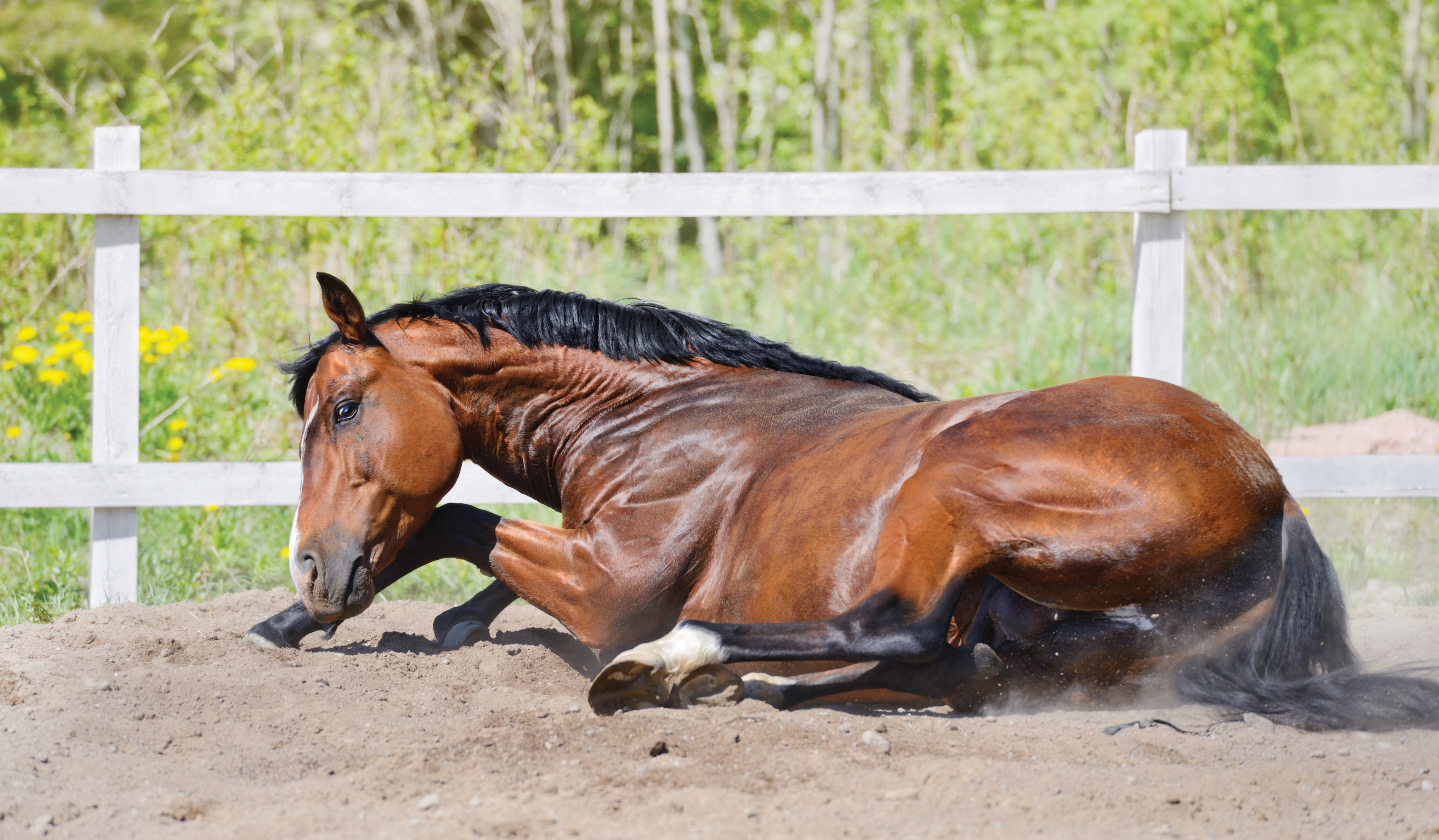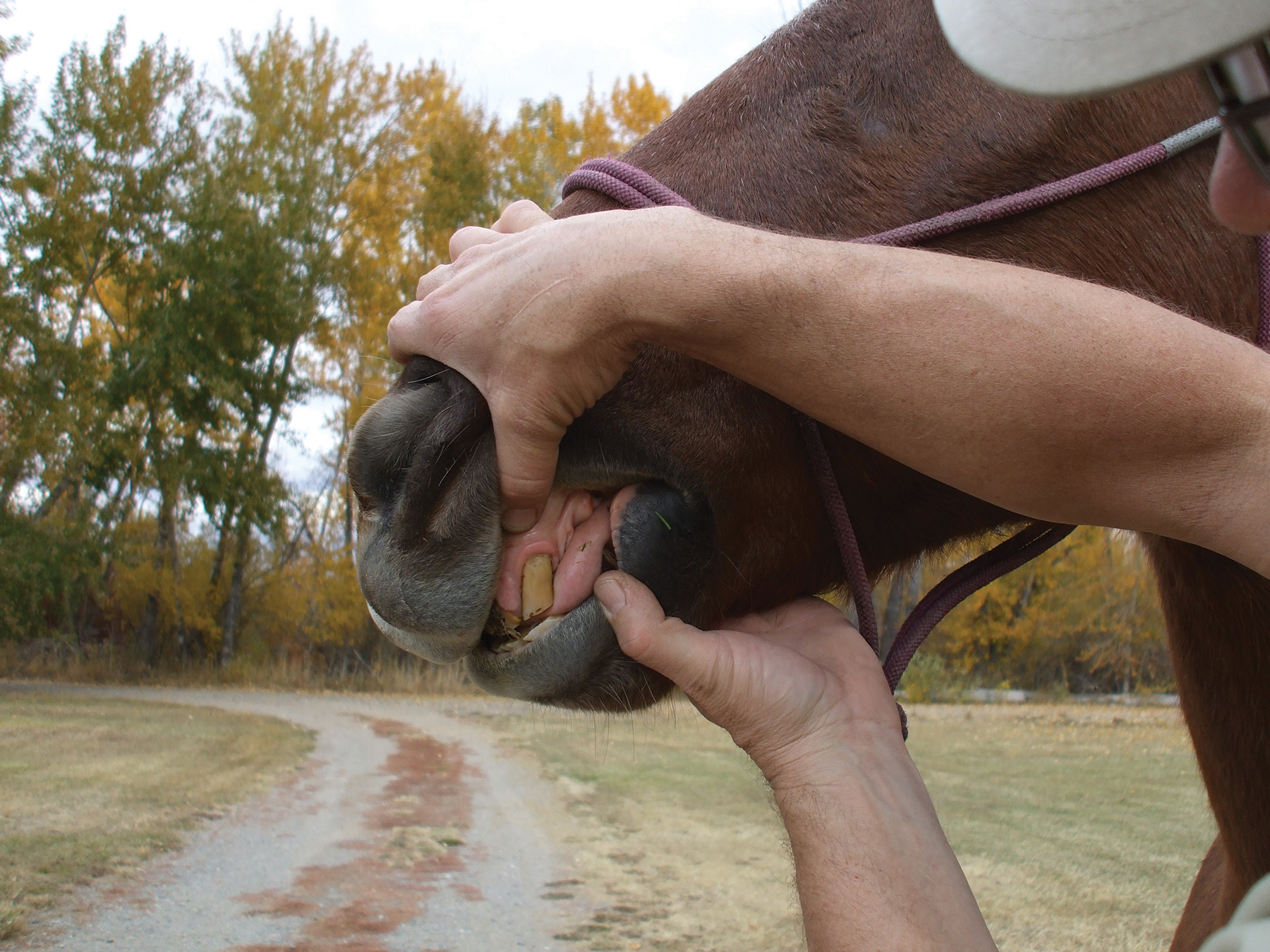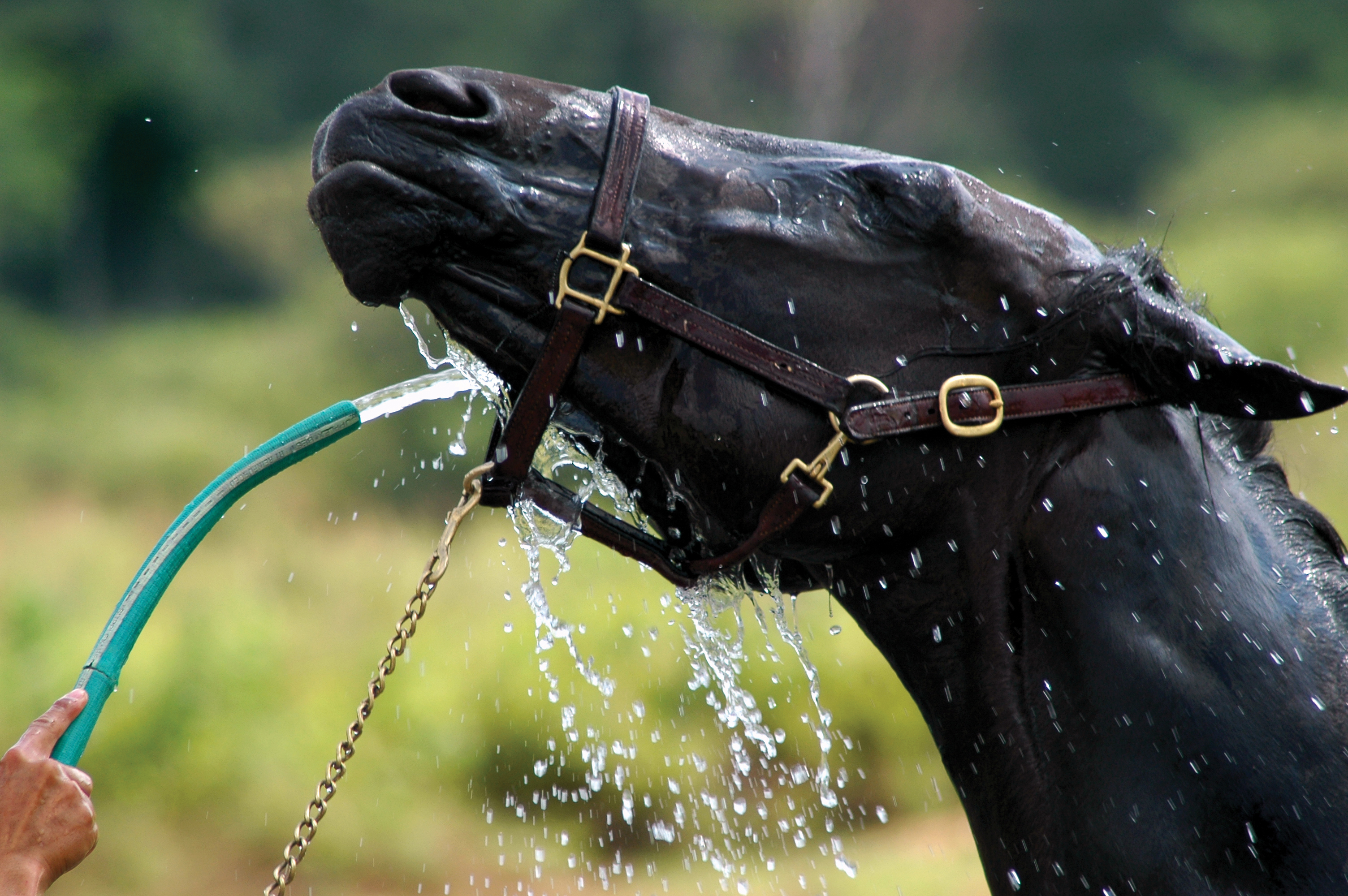
Heat Stress
 When ambient temperature and humidity rise to certain levels, an exercising horse might be in danger of developing heat stress, especially when hot weather is coupled with arduous and/or prolonged exertions. A hot day without humidity also poses a risk.
When ambient temperature and humidity rise to certain levels, an exercising horse might be in danger of developing heat stress, especially when hot weather is coupled with arduous and/or prolonged exertions. A hot day without humidity also poses a risk.
A horse demonstrating signs of heat stress – either subtle or obvious – could signal impending metabolic collapse. If any of these signs are seen, then it is necessary to stop the horse’s exercise immediately and begin implementing cooling strategies, described below. If the horse’s rectal temperature does not begin to return to normal within 15 minutes or so, a veterinarian should be contacted immediately.
Locomotion Abnormalities
• Flagging body posture under saddle
• Need to urge horse to
maintain speed
• Stride flattens out
• Poor impulsion
• Stumbling
• Ataxic (incoordination) or weak
Body Function Changes
• Waning or absent appetite
• Lack of thirst
• Reduced or absence of urination
• Reduced or absence of bowel movements
• Decreased intestinal sounds
Overt Problems
• Tying-up syndrome (myositis)
• Thumps (synchronous diaphragmatic flutter)
• Colic
• Neurologic abnormalities
Attitude and Posture Changes
• Grumpy disposition when handled
• Grumpy when asked to perform
• Lack of alertness or interest in surroundings
• Dull or glazed eyes
• Sagging or deflated posture at rest
• Wrinkled lips
• Ears at half-mast
• Anxious expression
 VITAL SIGNS
VITAL SIGNS
In addition to your horse’s display of posture, attitude, mood and intake of food and water, check vital signs to determine how well he is coping with the exercise demand and climate conditions of the day.
• Heart rate (or pulse): A horse’s pulse, or heart rate (measured in beats per minute), informs about how well he’s recovering from exercise. The heart rate should return to about 60 to 64 beats per minute within 10 minutes of stopping aerobic exercise, but will take a bit longer with sprint and anaerobic efforts. Poor heart rate recovery may signal impending metabolic collapse due to the combined effects of energy depletion, electrolyte loss, and heat build-up in the muscles.
• Respiration: The respiratory rate (breaths per minute) should return to normal within 10 minutes of stopping aerobic exercise, and a bit longer following sprint workouts. If the heart rate returns to 60 bpm or below but the respiratory rate remains elevated, such an inversion does not necessarily imply the horse is in trouble. It means he needs help in ridding his body of the extra heat. If the horse is panting, there may be nothing abnormal about the horse other than having bigger, bulkier muscles than a leaner-muscled breed. In other cases, it is a true reflection of limited fitness or being asked too much for the conditions of the day. Respiratory rate is a useful means of evaluating a horse’s ability to cope with the exercise demand, the pace, and heat and humidity.
• Gum color and capillary refill time: Lift the horse’s upper lip to evaluate the gums – they should be moist and pink, like what you see under your pinky nail. Press gently to blanche away the color and the gums should pink up again within two seconds. Slow capillary refill time and/or lack of moistness indicate dehydration.
• Skin turgor: To roughly estimate dehydration, pinch a fold of skin on the point of the shoulder or the upper eyelid. It should snap back into position immediately. If it doesn’t return to its normal position and remains “tented,” the horse is likely 3-5% dehydration. Pinching skin on the neck is not a reliable indicator of dehydration. Thin and/or fit horses have little subcutaneous fat and so the skin on the neck can remain tented even in a well-hydrated individual. The point of the shoulder and the upper eyelid more consistently reveal true skin turgor.
• Rectal temperature: Normal rectal temperature at rest runs less than 101 degrees Fahrenheit in an adult horse. Exercise may normally elevate rectal temperature to 101- 103 degrees Fahrenheit. A horse with a rectal temperature over 103.5 degrees Fahrenheit needs to be managed with cooling techniques. Once exercise is stopped, rectal temperature should decline steadily over 15 to 20 minutes. Rectal temperature exceeding 105 degrees Fahrenheit is dangerous, requiring immediate and aggressive cooling measures. At 106 degrees, kidney, liver, and brain damage can result. Rectal temperatures greater than 107 degrees may lead to convulsions, coma, or death.
 COOLING TECHNIQUES
COOLING TECHNIQUES
Many horses need assistance with cooling during and after workouts, especially in the summer months. Warm air temperature, especially coupled with high humidity, can prevent a horse from adequately dissipating internal heat from his body while exercising. Heat stress generally develops due to overexertion, leading to overheating rather than to external heating by the sun’s rays.
There are a variety of simple cooling strategies to use. While implementing these techniques, continue to monitor how well your horse is doing with intermittent assessment of vital signs and heart rate recovery.
• As a workout winds up, slow the horse to a walk for 5-10 minutes. The rider should hop off, remove the saddle and keep the horse walking so blood flow continues to flush metabolic waste products and heat from his muscles. Bringing a horse to a sudden and complete standstill after moderate to strenuous exercise causes blood to pool in the muscles. This compromises the circulating blood volume, contributing to relative dehydration while being counterproductive to cooling.
• Copiously bathe the horse’s head, neck, armpits and legs with cool water. Large blood vessels in these locations flush heat to the skin surface, and repeated soaking facilitates evaporative cooling. While the horse is walking, he can be sponged and soaked, and this can continue once he is finally stopped to rest.
• Continuously apply and scrape water away until the horse’s skin feels cool to touch. Don’t be tempted to drape wet towels over the head and neck and leave them in place. Towels act as an insulator, thereby limiting cooling.
• Heat normally radiates from the head to keep the brain cooler than the inner core temperature of the body; increase in heat to the brain contributes to central or mental fatigue. Bathe the head as well as large blood vessels of the neck (jugular veins and carotid arteries) and legs to facilitate movement of heat out of the central body core.
• Cooling a horse down too rapidly can cause chilling or muscle cramps (tying-up, myositis). In hot and humid climates, ice water may be applied to the entire body with less risk of muscle cramping. However, ice water baths in more arid climates may cause problems in large muscle groups – blood vessels constrict away from the surface while retaining metabolic byproducts and heat that need to be carried out from muscle depths. Besides exhibiting poor metabolic recoveries, the horse might develop “tying up” syndrome with painful muscle spasms. In arid climates, it is best to confine cooling baths only to areas in front of the withers.
• Monitor rectal temperature and muscle tone of the haunches as the horse is cooled down. Once rectal temperature reaches 101 degrees Fahrenheit and/or the chest feels cool to touch, cooling assistance can be paused or stopped.
• Offer drinking water following exercise. For horses that have been exercised at gallops or sprints, initially only offer small, frequent drinks. In contrast, horses working at steady aerobic paces can drink what they want.
• Shade is important to improve comfort and cooling. Find an area with good air circulation, preferably with a light breeze. Fans provide convective cooling – air flowing across the horse’s body pulls heat from the skin. Periodic, short walks help muscles pump heat away from deeper tissues.
If you see any abnormal signs (as described above) or if a horse isn’t cooling down appropriately within 15 minutes, contact your veterinarian immediately.
